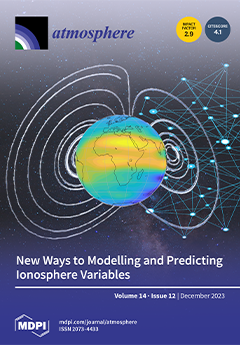Quantifying the level of CO
2, the main greenhouse gas (GHG), is essential for research on regional and global climate change, especially in the densely populated North China Plain with its severe CO
2 emissions. In this study, 12 airborne flights were
[...] Read more.
Quantifying the level of CO
2, the main greenhouse gas (GHG), is essential for research on regional and global climate change, especially in the densely populated North China Plain with its severe CO
2 emissions. In this study, 12 airborne flights were managed and conducted during the autumn–winter period of 2018–2019 in downtown Shijiazhuang and its surrounding areas, which are representative of the typical urban conditions in the North China Plain, to explore the spatial and temporal distributions of CO
2. The results showed that the measured columnar averages of CO
2 ranged between 399.9 ± 1.5 and 443.8 ± 31.8 ppm; the average of the 12 flights was 412.1 ppm, slightly higher than the globally averaged 410.5 ± 0.20 ppm and the 2 background concentrations of 411.6 ± 2.1 ppm and 411.4 ± 0.2 ppm in low-latitude Mauna Loa and middle-latitude Waliguan in 2019, indicating the potential influences of anthropogenic activities. The typical stratification of the planetary boundary layer (PBLH), residual layer (RL), and elevated inversion layer (IL) was crucial in constraining the high CO
2 concentrations. This illustrated that the warming effect of CO
2 within the PBLH may also have some influences on regulating the thermal structure of the low troposphere. Based on a backward trajectory analysis, it was evidenced that there were three different categories of air masses for autumn and one category for winter. Both trajectories in the PBL, i.e., below 1000 m, from the local and southern areas with tremendous anthropogenic emissions (autumn) and from the western regions (winter) led to comparatively high levels of CO
2, but the mid-tropospheric CO
2 concentrations above 1000 m were commonly homogeneously distributed, with higher levels appearing in winter because the concentration in the free troposphere followed the global seasonal pattern, with a summer minimum and winter maximum as a result of the seasonality of the net CO
2 exchange and the balance between photosynthesis and respiration. These results provide an in-depth understanding of the vertical concentrations of tropospheric CO
2 in the North China Plain, which will offer scientific references for the evaluation of carbon accounting and carbon emissions.
Full article





